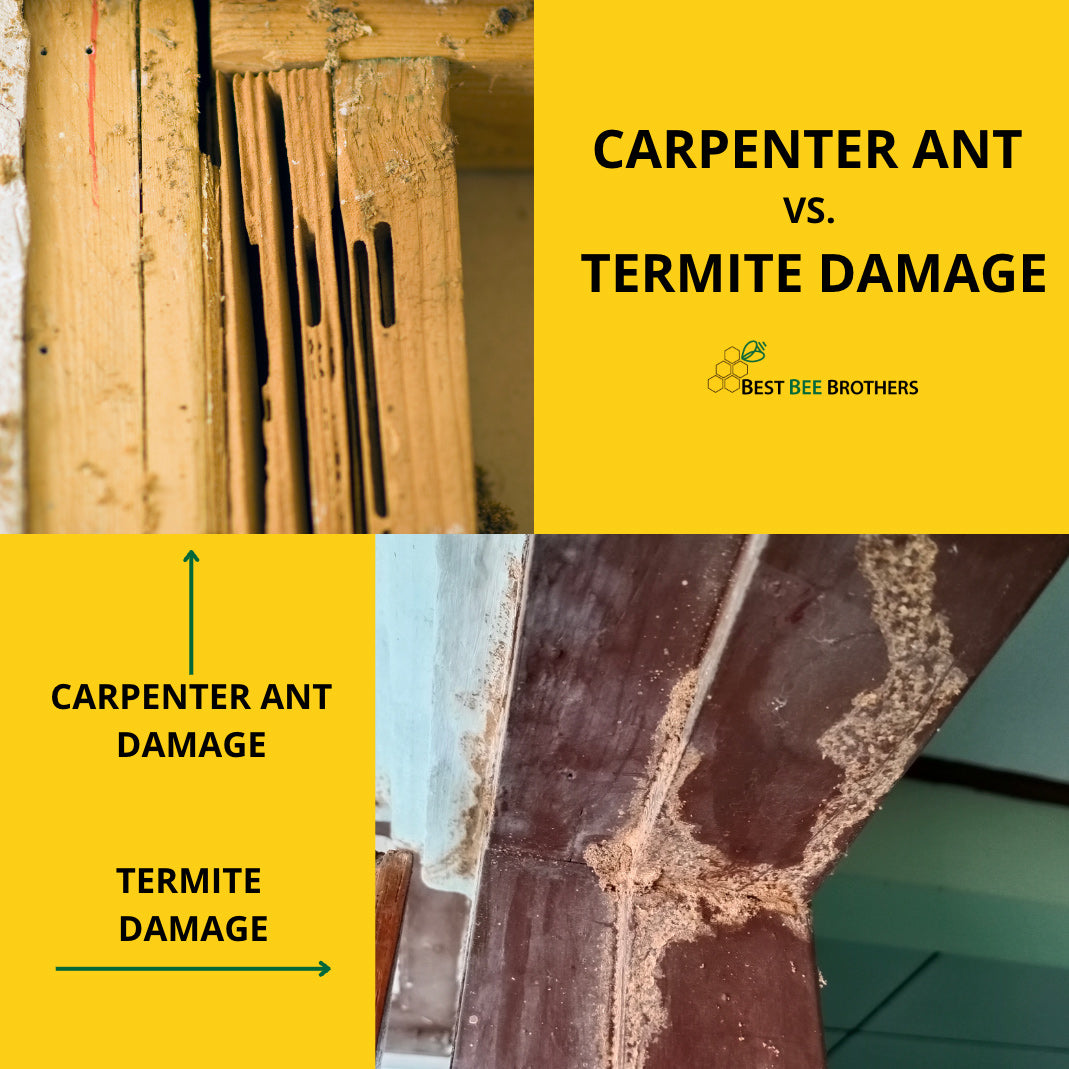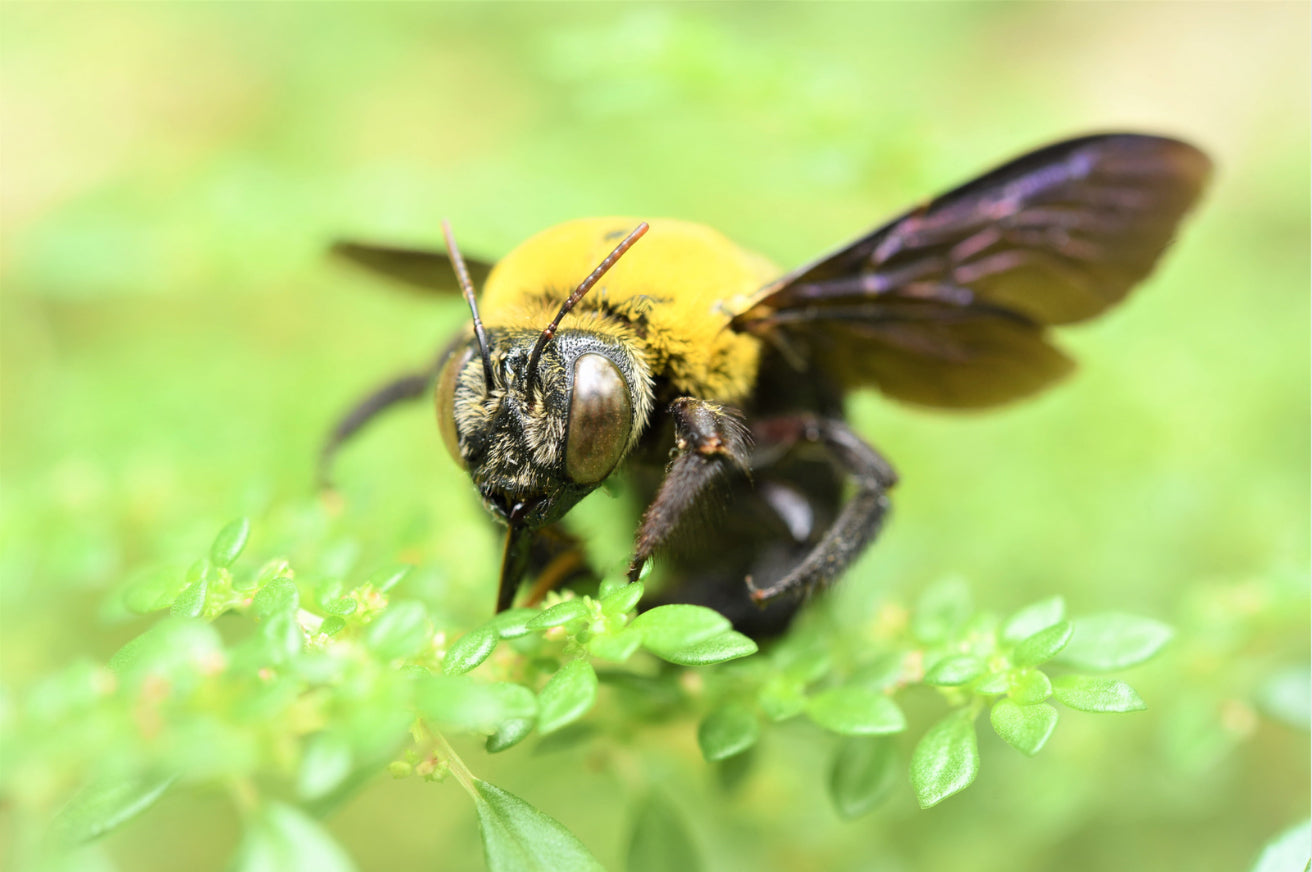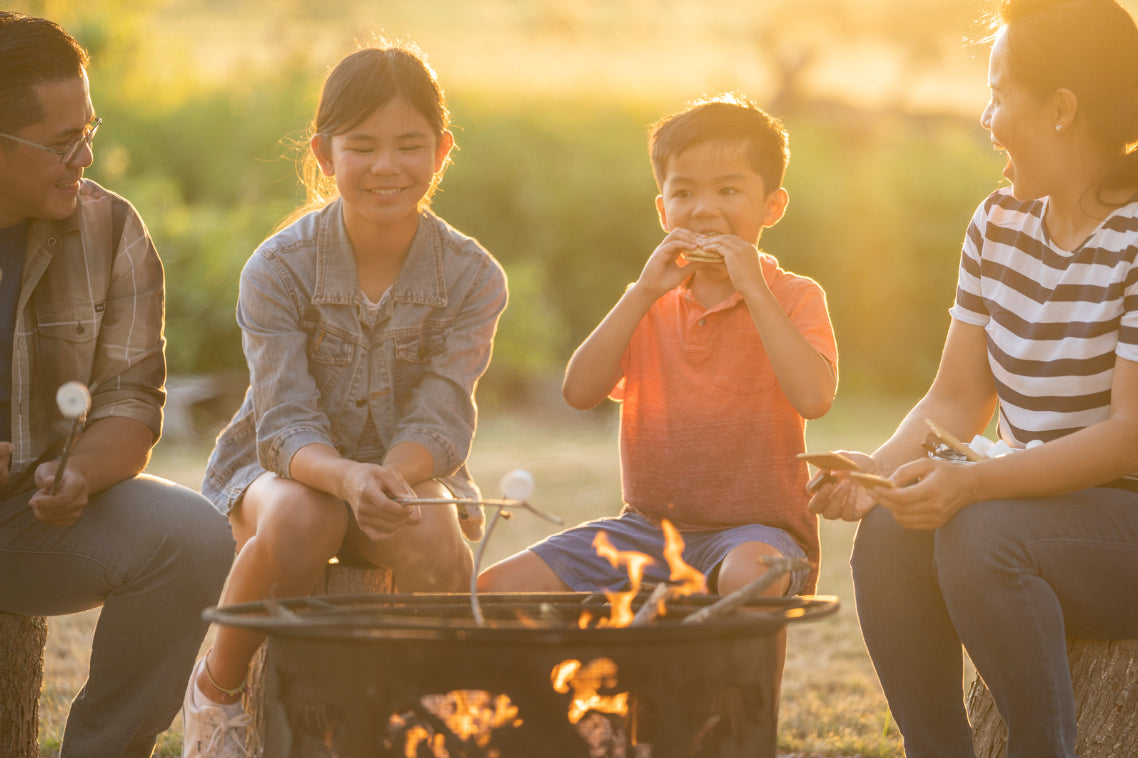Termites and carpenter bees are two types of wood damaging insects that are notorious for their destructiveness. In nature, they’re harmless parts of the life cycle of a forest, munching on or burrowing into decomposing wood. But when they find their way into homes or burrow inside porches or decks, these pests can pose a serious problem that have been known to do more than $5 billion in damages per year.1

How do you know which bugs are invading your home, and what can you do to stop them if you find an infestation? Fortunately, it’s easy to spot the differences between carpenter bees and termites.
Carpenter Bee Damage vs. Termite Damage: Spot the Difference
One of the telltale ways to distinguish termites from the brazen buzzing of a carpenter bee is simply to examine the damage left behind.
While termites munch on wood like they’re at an all-you-can-eat buffet, carpenter bees have a slightly different agenda. These bees prefer to drill into your wooden structures to make cozy nests for their growing families. And they’re no amateurs either! A lot of carpenter bee nests are almost perfectly cylindrical holes in your wooden siding, eaves and overhangs. So if you spot small, neatly rounded holes in your wood, chances are it’s a carpenter bee’s handiwork. And though carpenter bees are known for creating those signature round holes, their nests can attract the attention of woodpeckers, which enlarge those holes and cause further damage. 4


Termite vs. Carpenter Ant Damage: Spot the Difference
Wondering how to differentiate between termite and carpenter ant damage? While both can be a royal pain in the posterior, there are a few key differences in their behavior:
- Wood Appearance: Termite damage often results in wood that appears hollowed out from the inside (because that’s how termites like to operate: eating from the inside out)5. The damage may have a honeycomb-like texture, with galleries and tunnels running parallel to the grain. On the other hand, carpenter ant damage typically leaves the wood structurally intact, with smooth and clean tunnels excavated against the grain.
- Frass: Frass refers to the debris or excrement left behind by insects. Termite frass is often a powdery substance that resembles sawdust or sand. This is because, unlike carpenter ants, termites eat the wood. As a result, termites produce frass that is typically oval-shaped and uniform in size since their dietary intake doesn’t change much. (What’s on the menu tonight? WOOD!) In contrast, carpenter ants do not eat wood. Instead, they push it out of their galleries, resulting in visible piles of coarse, wood-colored debris, along with insect parts from their previous meals. It’s not an exact science, but compare the two side by side and you’ll notice the difference right away!
- Pest Activity: Observing the pests themselves can also provide clues. Termites are light-colored, soft-bodied insects that are rarely seen outside of their tunnels, though swarmers (winged, reproductive termites), may be attracted to light.6 In contrast, carpenter ants are larger and darker in color. You may spot them foraging around your property or near their nest entrances, especially during warmer months.
- Wing Size: Carpenter ants and termite swarmers shed their wings shortly after mating, and these can provide a valuable clue as to which pest you’re dealing with: termite wings are all the same size, and ant wings vary.7
Remember, no matter which species of insect you’re dealing with, early detection is the key to preventing a full-blown invasion. Regular inspections of your property, both indoors and outdoors, can help you stay one step ahead of these little troublemakers. Be proactive and act swiftly if you notice any of these signs.

Damage From Termite Bees
Termites are small insects that resemble flying ants. And like ants, they are social creatures that live and work in colonies made up of soldiers and workers that serve a king and queen.2 They prefer humid environments but can be found throughout the world and make their habitat all throughout North America. Termites are detritivores, which means they eat decomposing or dead plant material—including wood used in home construction.

Unfortunately, unless you know what to look for, there is often no sign of an infestation until it’s too late. It’s often best to consult with a professional pest control company that can conduct an inspection of your property to identify early-stage termite damage or take preventative measures before damage can occur.
Signs of Carpenter Bees
Carpenter bees are much larger than termites and are easy to spot (though they do resemble the beneficial bumblebee). They are solitary bees that don’t nest in large colonies, living instead in male-female pairs, sometimes with siblings. They are active in the warmer months from spring to fall. Each season, the female finds soft wood to construct a nest a nest and bores tunnels up to four feet long, where she will lay the larvae while the male protects the area.

Unlike termites, which often damage foundations and wreak havoc in other hidden places, carpenter bee damage is more obvious. The bees don’t eat wood but instead burrow into it, boring perfect half-inch-wide holes and leaving telltale sawdust behind. Check for carpenter bee damage on wooden areas of your home’s exterior, especially eaves, rafters, siding, cedar shake roofs, and on decks and outdoor furniture.3

If you find carpenter bee damage to your property or want to prevent it in the future, carpenter bee traps can take care of the problem. Our Best Bee Trap is the most effective and professional carpenter bee trap solution on the market. We also have other carpenter bee solutions including bee bait. If you have any questions feel free to reach out to us. We would be happy to help prevent prevent carpenter bee damage.
- “Termites Pose Silent - but Very Real - Threat to Homes across the U.S.,” March 22, 2010, National Pest Management Association, accessed October 16, 2020, https://www.pestworld.org/news-hub/press-releases/termites-pose-silent-but-very-real-threat-to-homes-across-the-us/.
- Michael F. Potter, “ENTFACT-611: Carpenter Bees,” University of Kentucky College of Agriculture, Food and Environment, University of Kentucky, accessed October 16, 2020, https://entomology.ca.uky.edu/ef611.
- “Termites,” NC State University Agriculture and Life Sciences, accessed October 16, 2020, https://genent.cals.ncsu.edu/bug-bytes/social-insects/termites/.
- Elizabeth Barnes, "Carpenter Bees: What's That Buzzing Around Your Porch?," June 7, 2021, https://ag.purdue.edu/department/btny/ppdl/potw-dept-folder/2021/carpenter-bees.html.
- “What Is a Termite Inspection and Why Do You Need One?,” PestWorld, National Pest Management Association, accessed May 25, 2023, https://www.pestworld.org/news-hub/pest-articles/what-is-a-termite-inspection/.
- “Nicole Fallon, “Solved! What Do Termite Droppings Look Like, and Are They a Sign of an Infestation?,” Bob Vila, January 27, 2023, https://www.bobvila.com/articles/termite-droppings/.
- Sydney Crawley and Christopher C. Hayes, “Termite Swarmers - What Do They Mean for You?,” NC Extension, February 24, 2023, https://content.ces.ncsu.edu/termite-swarmers-what-do-they-mean-for-you.
- Crawley and Hayes, “Termite Swarmers.”









Leave a comment
All comments are moderated before being published.
This site is protected by hCaptcha and the hCaptcha Privacy Policy and Terms of Service apply.